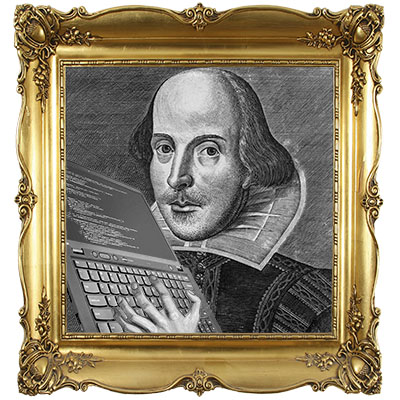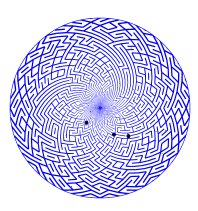Today I’ll offer a discussion of porting and translation in computational art and literature at the ATNE Salon, Boston Cyberarts Gallery. The event’s at 7:30pm; the gallery is in the Green Street T Station, on the Orange Line in Jamaica Plain.
Forbidden
You don’t have permission to access /memslam/IN A GREEN, MOSSY TERRAIN,IN AN OVERPOPULATED AREA,BY THE SEA,BY AN ABANDONED LAKE,IN A DESERTED FACTORY,IN DENSE WOODS,IN JAPAN,AMONG SMALL HILLS,IN SOUTHERN FRANCE,AMONG HIGH MOUNTAINS,ON AN ISLAND,IN A COLD, WINDY CLIMATE,IN A PLACE WITH BOTH HEAVY RAIN AND BRIGHT SUN,IN A DESERTED AIRPORT,IN A HOT CLIMATE,INSIDE A MOUNTAIN,ON THE SEA,IN MICHIGAN,IN HEAVY JUNGLE UNDERGROWTH,IN AN OVERPOPULATED AREA,BY A RIVER,AMONG OTHER HOUSES,IN A DESERTED CHURCH,IN A METROPOLIS,UNDERWATER on this server.
Memory Slam and Code Poetry at ITP
I was delighted to be at the first NYU ITP Code Poetry Slam a few hours ago, on the evening of November 14, 2014. The work presented was quite various and also very compelling. Although I had an idea of what was to come (as a judge who had seen many of the entires) the performances and readings exceeded my high expectations.
A reading I did from historical computational poetry kicked off the event. I read from a new set of reimplementations, in JavaScript and Python, that I developed for the occasion. The set of four pages/Python programs is called Memory Slam. It contains:
Love Letters
Christopher Strachey, 1952
Stochastic Texts
Theo Lutz, 1959
Permutation Poems
Brion Gysin & Ian Somerville, 1960
A House of Dust
Alison Knowles & James Tenney, 1967
These are well-known pieces, at least among the few of us who are into early computational poetry. (Chris Funkhouser and his Prehistorical Digital Poetry is one reason we know these and their importance; Noah Wardrip-Fruin has also offered a great discussion of Love Letters, and Stephanie Strickland, who was in attendance at the slam, has done two collaborative poems based on A House of Dust, one with me and one with Ian Hatcher.) Some implementations exist already of many, perhaps all of them – although I did not find one for A House of Dust. My point in putting these together was not to do something unprecedented, but to provide reasonably clean, easily modifiable versions in two of today’s well-known languages. This will hopefully allow people, even without programming background, to learn about these programs through playing with them.
If I didn’t implement everything perfectly, these are explicitly free software and you should feel free to not only play with them but to improve them as well.
NaNoGenMo 3000!!!!
Er, sorry. I exaggerated a bit. It’s actually just
NaNoGenMo 2014. But that’s still really cool.
“Spend the month of November writing code that generates a novel of 50k+ words.” As is traditional, the event occurs on GitHub.
Polish Reviews of World Clock
I mentioned a few of these earlier, but there are more. I’ll try to keep an updated list of reviews here for any curious Polish-reading visitors:
Update Jan 31, 2015: Review of Zegar światowy in PROwincja.
Update Jan 31, 2015: Review of Zegar światowy in Lubimyczytać.pl.
Update Jan 19, 2015: Review of Zegar światowy in Kulturnatywnie.pl.
Update Jan 8, 2015: Review of Zegar światowy in kanapa.it.
Update Dec 15, 2014: Review of Zegar światowy in sztukater.pl.
Update Dec 15, 2014: Review of Zegar światowy in sZAFa – kwartalnik literacko-artystyczny.
Update Dec 10, 2014: Review of Zegar światowy in Szuflada.net
Update Dec 10, 2014: Review of Zegar światowy in Popmoderna.
Update Nov 13, 2014: Review of Zegar światowy in Stacja Książka.
Update Nov 4, 2014: Review of Zegar światowy in Altmundi.
Update Oct 31, 2014: Review of Zegar światowy in Gazeta Wyborcza.
Update Oct 30, 2014: Review of Zegar światowy in kulturalnie.waw.pl.
Review of Zegar światowy in Portal (nie całkiem) Kulturalny.
Review of Zegar światowy in SZORTAL.
Review of Zegar światowy by Katarzyna Krzan.
Review of Zegar światowy in Pad Portal.
Review of Zegar światowy by Julia Poczynok.
There was also a review of Zegar światowy in the major Polish weekly magazine Przegląd (the review is not online).
The book was also discussed in an interview I did on Radio Kraków.
The First Review of #!
Finally, the first review of my book #! is in. It’s from Zach Whalen. this is it, and to make it easier for you to copy, paste, and run it, here is the review that he banged out:
perl -e '{print$,=$"x($.+=.05),map{$_ x($.*.1)}qw(# !);redo}'
By the way, please come to my reading tomorrow at MIT (E15 atrium) at 6:30pm if you’re in the area. It will be fun!
More Human at Cyberarts
Here are some photos from the opening of the show More Human at the Boston Cyberarts Gallery on September 12.
The site for the show also features a PDF of the catalog [2.5 MB].
My piece in the show is From the Tables of My Memorie. I read a bit from the piece last night, when I spoke at Boston Cyberarts with several other artists about our work and the theme of the show.
I’ll be speaking at the Boston Cyberarts Gallery again on November 19, this time about ports and translations in computational art – the topic of my Renderings project. That event is at 7:30pm. The gallery is in the Green St T Station on the Orange Line.
Code Poetry Slam in NYC Seeks Entries
ITP (the Interactive Telecommunications Program) at NYU is having a Code Poetry Slam on November 14. And they are seeking entries now! Send them along no later than November 7.
10 PRINT in Clock 52
Clocks are great machines to design, at least from my perspective as a designer of software machines. My classes have had unusual clock design as an exercise; time-telling systems are not interactive, provide a lot of freedom to the designer, and yet require programmers to develop general functions that work for any time of the day. I know that Michael Mateas and Paolo Pedercini have students program clocks, too. I’ve appreciated software clocks by John Maeda and others, and it’s nice to have a clock as a standard example in Processing.
So, I was delighted to see that 10 PRINT CHR$(205.5+RND(1)); : GOTO 10 inspired Vincent Toups to create a another of his many aesthetic software clocks, Clock 52.
Microcodes and more Non-Object Art
In NOO ART, The Journal of Objectless Art, there’s a conversation between Páll Thayer and Daniel Temkin that was just posted. (Thayer recently collaborated with me to put up “Programs at an Exhibition,” the first software art show at the Boston Cyberarts Gallery.) The conversation covers Thayer’s code art, including his Perl Microcodes and antecedents, but also touches on free software, Windows, various esoteric languages by Temkin and others, painting and drawing, Christiane Paul’s CodeDOC project at the Whitney, “expert cultures,” and the future of code-based art.
It’s great reading, and objectless art might be just the thing to go with your object-oriented ontology.



